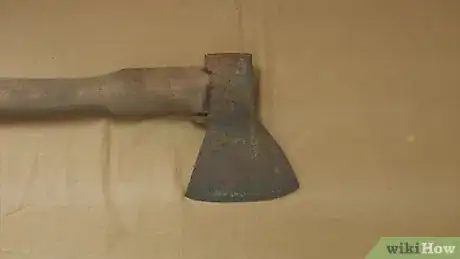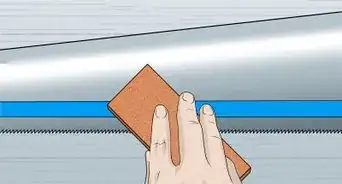This article was co-authored by wikiHow Staff. Our trained team of editors and researchers validate articles for accuracy and comprehensiveness. wikiHow's Content Management Team carefully monitors the work from our editorial staff to ensure that each article is backed by trusted research and meets our high quality standards.
This article has been viewed 426,688 times.
Learn more...
Using a dull axe is not just ineffective — it can also be dangerous, resulting in the blade glancing off the wood instead of lodging in for a clean cut. Sharpening an axe can be tedious, but you'll make up for lost time after a day of work with the honed, efficient edge.
Steps
Filing a Dull Axe
-
1Protect your hands and face. Take these steps to avoid injury while sharpening an axe:
- Wear thick leather gloves.
- If your file does not have a finger guard, cut a slit in a piece of leather and fit it onto the file.[1]
- Wear safety goggles to protect against metal dust.
- A dust mask is optional for hand sharpening. A respirator is recommended if you use power tools (but see Tips below.)
-
2Clean and polish the head of the axe. If there is any rust on your axe, clean it off with a rust eraser or steel wool. Further polishing is mostly a matter of aesthetics, but not too difficult to accomplish:[2]
- Sand with coarse-grit aluminum oxide or silicon carbide sandpaper. Rub the axe head with even pressure, moving from the poll (hammer end) to the blade.
- Repeat with finer-grit sandpaper.
- For excellent polish, repeat with extra-fine sandpaper and/or finish by applying a metal polish with a rag. (You may wait on this step until after sharpening.)
Advertisement -
3Clamp the axe in a vice. Clamp the axe horizontally for easier filing, or vertically for a more even edge (as this allows you to alternate sides). If clamping horizontally, you may wish to tilt the axe to the angle of the bevel (usually 20 or 30º), so you can hold the file parallel to the table. This is easier than judging the correct angle by sight.
-
4Select a bastard file. A 10–12" (25–30cm) bastard mill file (coarse, single-cut, and slightly tapering) is the best choice for most axes. Shorter bastard files do not have the same density of teeth, so the length is not just a matter of convenience. You may use a smaller mill file for hatchets.
- Clean clogged file teeth with a file card. If the file is new, rub soft chalk over it to prevent clogging.
-
5Inspect the bevel of the axe. Most axes have a slightly convex edge, about 20–30º. Broader, more convex edges are more suitable for hardwood or frozen wood, as the curve pushes wood out of the way to protect the edge. Carving axes have a straight, triangular point.[3] Decide on your axe's shape before you begin sharpening, and keep a close eye on the edge as it develops. In most cases, you'll want to match the existing bevel, following the curve of the blade to remove an even layer of metal.
-
6File with a steady motion into the blade. Hold the file handle in the palm of your dominant hand, with your thumb resting on top. Curl the fingers of your other hand around the tip of the file. Stand with one foot well in front of the other so you can use your shoulders to push the file. To prevent the file from rocking back and forth, lead with your forward hand, then transfer smoothly to a push with the handle by the end of the stroke.
-
7File repeatedly along a fan-shaped area. File into the edge in steady strokes. Create a fan-shaped curve on the blade by varying the starting point of your stroke: start close to the edge at the top of the axe head, start about 2–3 inches (5–7.5 cm) when at the center, and curve back down to the edge again at the bottom of the axe head.
- Do not make contact with the blade on the return stroke, as this will not sharpen the axe and may ruin your file.
- Use a file card or wire brush to remove metal particles from the file when buildup occurs.
-
8Switch to the other side when you can feel a burr. Once you feel a burr on the side you are not sharpening, turn the axe over and repeat the same steps on the other side of the edge. Continue sharpening until the burr returns to the first side.[4]
- Switching sides more frequently throughout the process may result in a more even edge.
-
9Measure the edge with a bevel gauge. Also called a sliding bevel, this is simply two hinged arms which you can tighten to any angle using a nut. You can easily make this yourself out of scrap lumber.[5] Set your bevel gauge to the desired angle using a protractor (usually 25º or so), then slot it over your axe edge. If the angle is off, file further to remove material where needed.
Sharpening the Axe
-
1Sharpen the edge with a coarse whetstone. Apply honing oil or sewing machine oil to the extreme edge, then rub the tip of a coarse whetstone along it in a circular motion. Sharpen both sides alternately to move the burr from one side to the other, until it is nearly gone. This burr is the "feather edge," or a very thin, bent end. Run your finger along the edge to track its shape.[6]
-
2Sharpen with a fine whetstone or a leather strop (optional). To remove the feather edge completely, repeat the same honing process with a finer whetstone, or strop it away from the edge with a strap of leather. A perfectly sharpened edge will not reflect any light, but a couple small nicks are not a big deal.
- Most whetstones are two-sided, with a coarse and a fine side. Examples with a finger groove in the middle are safer.
- Repeat the honing (at least with the coarse stone) each time you're about to use the axe.
-
3Protect the blade from rust. Wipe the blade with light machine oil, then rub in a mixture of beeswax and more oil. This works best when the steel is warm.[9]
Warnings
- Splitting mauls (splitting axes) are not made to be sharp. Keep the edge dull for safety.⧼thumbs_response⧽
- Replace the handle if you see any cracks or defects in the wood.[11]⧼thumbs_response⧽
Things You'll Need
- Rust eraser or steel wool
- Sandpaper
- Safety goggles
- Metal-polishing paste
- Felt pad or rag
- Heavy duty leather gloves
- Vice or table and clamp
- Bastard file
- File card or wire brush
- Axe gauge
- Oil or water whetstone
- Machine oil
- Beeswax
References
- ↑ http://www.fhwa.dot.gov/environment/recreational_trails/publications/fs_publications/99232823/page15.cfm
- ↑ http://www.artofmanliness.com/2012/07/17/how-to-restore-an-heirloom-axe/
- ↑ https://www.gransforsbruk.com/en/axe-knowledge/caring-for-your-axe/
- ↑ http://www.fhwa.dot.gov/environment/recreational_trails/publications/fs_publications/99232823/page15.cfm
- ↑ http://www.docgreenwoodturner.com/bevelgauge.html
- ↑ https://www.gransforsbruk.com/en/axe-knowledge/caring-for-your-axe/
- ↑ https://www.gransforsbruk.com/en/axe-knowledge/caring-for-your-axe/
- ↑ http://www.fhwa.dot.gov/environment/recreational_trails/publications/fs_publications/99232823/page15.cfm
- ↑ http://www.fhwa.dot.gov/environment/recreational_trails/publications/fs_publications/99232823/page15.cfm
About This Article
To sharpen an axe, start by rubbing the edge of the axe with honing oil or sewing machine oil. Next, rub the tip of a coarse whetstone along the edge in a circular motion. Make sure to sharpen both sides alternately, and periodically run your finger along the edge to ensure that both sides are perfectly straight and smooth. Finally, wipe the blade with machine oil, then rub in a mixture of beeswax and machine oil to protect the blade from rust. To learn more, including how to sharpen your axe with a mill file, scroll down!





























































